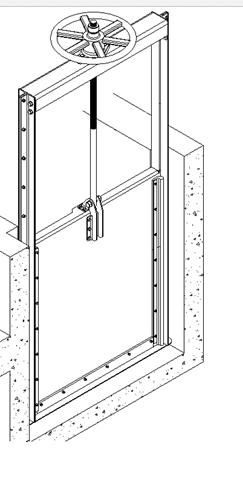I would find out from the H&H people what the flow velocity will be. My guess is that it's low.
Your flowline is at ~144' and the top of baffle wall is at 147', so that's only 3ft extra. If the flow velocity was anything material, then your sluice gate wouldn't buy you much time. My gut tells me that the hydrostatic load will be the greatest. It's only 4ft of head, so still not that much.
For your wall, I think I would start at a 10" thickness, but maybe bump it to 12".
Here are the reasons:
1) The wall could see pressure from both sides, so you need 2 curtains of steel. That automatically means you need at least an 8" thick wall.
2) The sluice gate will have anchor bolts attaching it to the wall. These might have a 6" embedment. By going to a 10" thick wall, you will have at least 4" of concrete on the far side of the anchors, and the anchor tips should not be hitting the far side rebar cage.
Other things to think about:
Junction box/manhole size - There needs to be enough room to bolt up the sluice gate. If your opening is 24" in diameter, you need room on the left and right sides to mount the gate. Absolute bare minimum is 8" extra space on each side, but I would argue for more just to make sure they can get room to drill holes, etc. It's nice to have 12"+ inches of free space around your opening. You also want room to get some continuous rebar in the wall.
What type of sluice gate will you be installing? Is it a 'self contained gate' or a 'non-self contained gate' (you should google this). A 24" gate will not weigh much, but this becomes very important on larger gates. The stem carries the load of the gate when it's opened. For a 'non-self contained' gate, that load goes strait up the stem to the top of your man-hole. This means your steel grating/platform at the top needs to be stronger. A 'self-contained' gate has a steel frame with built in beam. The gate's self weight is carried by the beam and then sent into your concrete wall. The steel grating and platform at the top of the well does not have to carry the gate weight.


